
The Tower (XVI) (most common modern name) is the 16th trump or Major Arcana card in most Italian-suited tarot decks. It has been used in Tarot cards since the 15th century as well as in divination since the mid-19th century.

The Tower (XVI) (most common modern name) is the 16th trump or Major Arcana card in most Italian-suited tarot decks. It has been used in Tarot cards since the 15th century as well as in divination since the mid-19th century.

This card follows immediately after The Devil in all tarots that contain it, and is associated with sudden, disruptive revelation, and potentially destructive change. Some early painted decks, such as the Visconti-Sforza tarot, do not contain it, [1] and some tarot variants used for gameplay omit it. [2]
Early printed decks that preserve all their cards do feature The Tower. In these decks the card bears a number of different names and designs. In the Minchiate deck, the image usually shown is of two nude or scantily clad people fleeing the open door of what appears to be a burning building. In some Belgian tarots and the 17th-century tarot of Jacques Viéville, the card is called La Foudre or La Fouldre ('The Lightning'), and depicts a tree being struck by lightning. In the Tarot of Paris (17th century), the image shown is of the Devil beating his drums, before what appears to be the mouth of Hell; the card still is called La Fouldre. The Tarot of Marseilles merges these two concepts, and depicts a burning tower being struck by lightning or fire from the sky, its top section dislodged and crumbling. Two men are depicted in freefall against a field of multicolored balls. [3] Pamela Colman Smith's version is based on the Marseilles image, with small tongues of fire in the shape of Hebrew yod letters replacing the balls. [4]
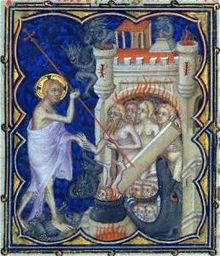

A variety of explanations for the images on the card have been attempted. For example, it may be a reference to the biblical story of the Tower of Babel, where God destroys a tower built by mankind to reach Heaven. [5] Alternatively, the Harrowing of Hell was a frequent subject in the liturgical drama of the Late Middle Ages, and Hell could be depicted as a great gate knocked asunder by Jesus Christ. The Minchiate version of the deck may represent Adam and Eve's expulsion from the Garden of Eden. [3]
The Tower is widely associated to danger, crisis, sudden change, destruction, higher learning, and liberation. [6] In the Rider–Waite deck, the top of The Tower is a crown, which symbolizes materialistic thought being bought cheap, downcast. [7]
The Tower is associated with the planet Mars. [8]
According to A. E. Waite's 1910 book The Pictorial Key to the Tarot , [9] the Tower card is associated with:
16. THE TOWER.-- Misery, distress, indigence, adversity, calamity, disgrace, deception, ruin. It is a card in particular of unforeseen catastrophe. Reversed: Negligence, absence, distribution, carelessness, distraction, apathy, nullity, vanity.

Tarot is a pack of playing cards, used from at least the mid-15th century in various parts of Europe to play card games such as Tarocchini. From their Italian roots, tarot-playing cards spread to most of Europe, evolving into a family of games that includes German Grosstarok and modern games such as French Tarot and Austrian Königrufen. In the late 18th century French occultists made elaborate, but unsubstantiated, claims about their history and meaning, leading to the emergence of custom decks for use in divination via tarot card reading and cartomancy. Thus, there are two distinct types of tarot packs in circulation: those used for card games and those used for divination. However, some older patterns, such as the Tarot de Marseille, originally intended for playing card games, are occasionally used for cartomancy.

The Major Arcana are the named or numbered cards in a cartomantic tarot pack, the name being originally given by occultists to the trump cards of a normal tarot pack used for playing card games. There are usually 22 such cards in a standard 78-card pack, typically numbered from 0 to 21. The name is not used by tarot card game players.

The Rider–Waite Tarot is a widely popular deck for tarot card reading, first published by the Rider Company in 1909, based on the instructions of academic and mystic A. E. Waite and illustrated by Pamela Colman Smith, both members of the Hermetic Order of the Golden Dawn. Also known as the Waite–Smith, Rider–Waite–Smith, or Rider Tarot, the deck has been published in numerous editions and inspired a wide array of variants and imitations. Estimates suggest over 100 million copies of the deck circulate across 20 countries.

The Magician (I), also known as The Magus or The Juggler, is the first trump or Major Arcana card in most traditional tarot decks. It is used in game playing and divination.
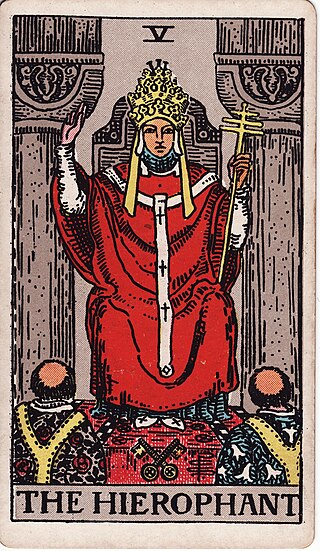
The Hierophant (V), alternatively depicted as The Pope or The High Priest (as a counterpart to "The High Priestess") is the fifth card of the Major Arcana in occult Tarot decks used in divination. It was identified as the Pope in early decks like Tarot of Marseilles, while modern decks like Rider–Waite Tarot may use the term hierophant (Ancient Greek: ἱεροφάντης), a person who brings religious congregants into the presence of that which is deemed "holy".

Death (XIII) is the 13th trump or Major Arcana card in most traditional tarot decks. It is used in tarot card games as well as in divination. The card typically depicts the Grim Reaper, and when used for divination is often interpreted as signifying major changes in a person's life.

The Hanged Man (XII) is the twelfth Major Arcana card in most traditional tarot decks. It is used in game playing as well as in divination.
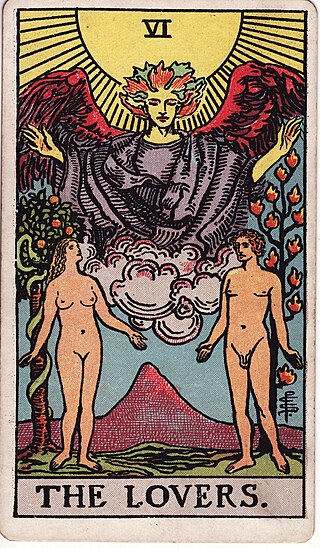
The Lovers (VI) is the sixth trump or Major Arcana card in most traditional Tarot decks. It is used in game playing as well as in divination.
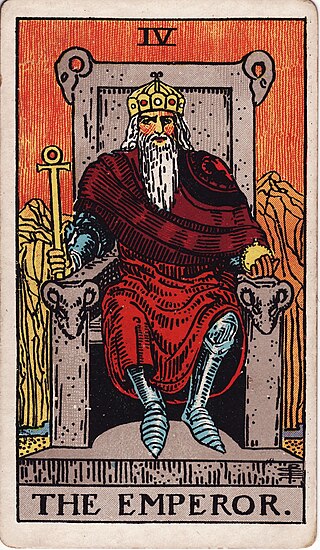
The Emperor (IV) is the fourth trump or Major Arcana card in traditional tarot decks. It is used in game playing as well as in divination.

Strength is a Major Arcana tarot card, and is numbered either XI or VIII, depending on the deck. Historically it was called Fortitude, and in the Thoth Tarot deck it is called Lust. This card is used in game playing as well as in divination.

The Hermit (IX) is the ninth trump or Major Arcana card in most traditional tarot decks. It is used in game playing as well as in divination.
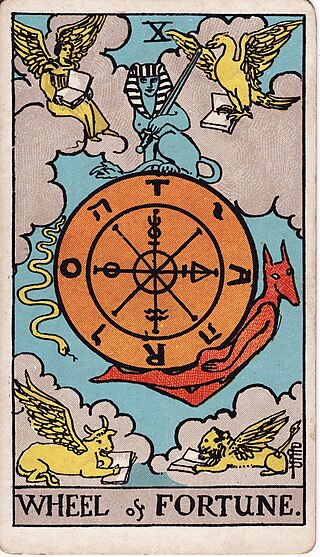
Wheel of Fortune is one of 78 cards in a tarot deck and is the tenth trump or Major Arcana card in most tarot decks. It is used in game playing as well as in divination.

Justice is a Major Arcana tarot card, numbered either VIII or XI, depending on the deck. This card is used in game playing as well as in divination.
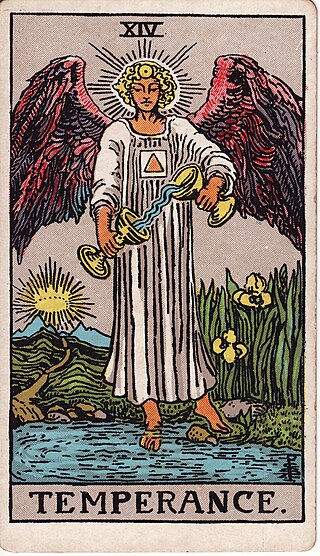
Temperance (XIV) is one of the 22 Major Arcana cards in Tarot decks. It is usually numbered 14. It depicts a figure which represents the virtue Temperance. Along with Justice and Strength, it is one of three Virtues which are given their own cards in traditional tarot. It is used in both game playing and in divination.

The Devil (XV) is the fifteenth trump or Major Arcana card in most traditional tarot decks. It is used in game playing as well as in divination.

The Moon (XVIII) is the eighteenth trump or Major Arcana card in most traditional tarot decks. It is used in game playing as well as in divination.
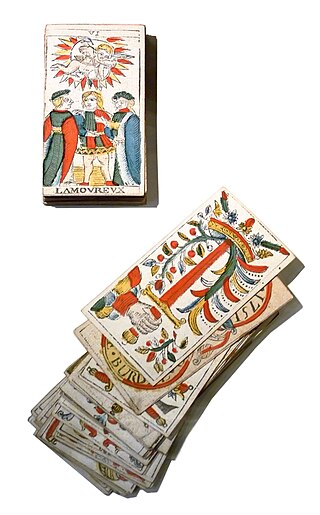
The Tarot of Marseilles is a standard pattern of Italian-suited tarot pack with 78 cards that was very popular in France in the 17th and 18th centuries for playing tarot card games and is still produced today. It was probably created in Milan before spreading to much of France, Switzerland and Northern Italy. The name is sometimes spelt Tarot of Marseille, but the name recommended by the International Playing-Card Society is Tarot de Marseille, although it accepts the two English names as alternatives. It was the pack which led to the occult use of tarot cards, although today dedicated decks are produced for this purpose.

The Queen of Swords is a card in the suit of swords, part of the Minor Arcana set of the tarot.

Tarot card reading is a form of cartomancy whereby practitioners use tarot cards to purportedly gain insight into the past, present or future. They formulate a question, then draw cards to interpret them for this end. A traditional tarot deck consists of 78 cards, which can be split into two groups, the Major Arcana and Minor Arcana. French-suited playing cards can also be used; as can any card system with suits assigned to identifiable elements.

The Fool is one of the 78 cards in a tarot deck. In tarot card reading, it is one of the 22 Major Arcana, sometimes numbered as 0 or XXII. However, in decks designed for playing traditional tarot card games, it is typically unnumbered, as it is not one of the 21 trump cards and instead serves a unique purpose by itself.
{{cite book}}: CS1 maint: multiple names: authors list (link) CS1 maint: numeric names: authors list (link)